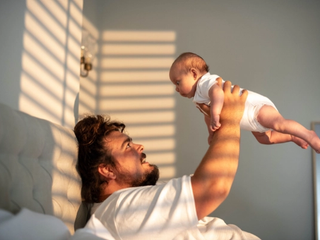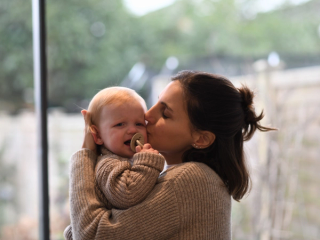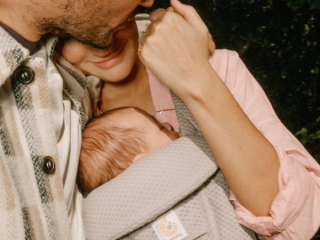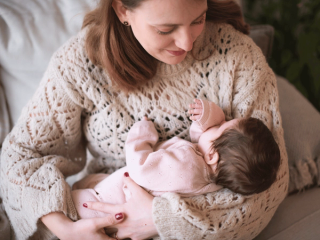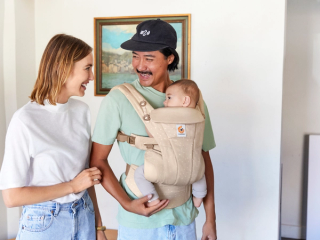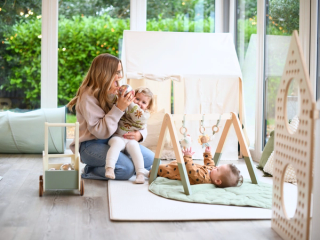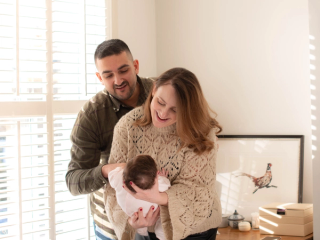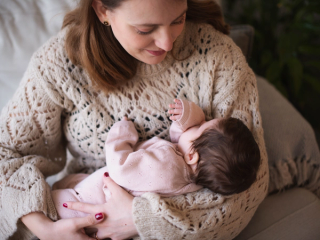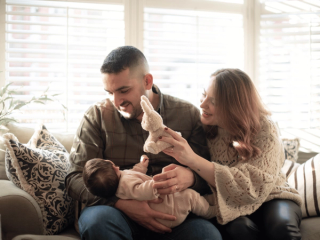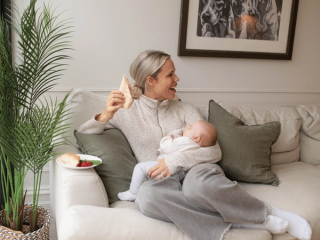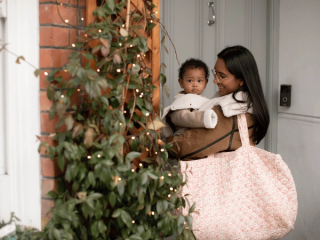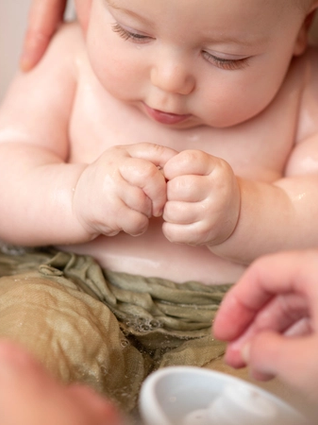
- Home
- Advice Hub
- Newborn
- New Parent Support
- How To Bathe Your Baby
How to bathe your baby
Reviewed by Christine Lane, Midwife and Consultant, on the 24.09.2025
Your baby’s first bath is one of those moments every parent remembers – mostly because it can be so daunting! Newborns are tiny, squirmy and quite slippery when wet, so it’s no wonder lots of parents are apprehensive when it’s time to introduce their little one to the water for the first time.
Never fear, though – bathing your baby isn’t as hard as you may imagine, and it can be a very enjoyable experience for all. Here are some tips to help you get the hang of it.
When should a newborn have their first bath?
Though newborn babies may appear as if they need a wash, it’s actually best to hold off on bathing them straight away. The whiteish vernix coating their skin acts as a natural barrier against germs, and it's important not to remove it too soon – allowing it to absorb helps protect against bacterial infections and keeps their delicate skin moisturised. Postponing that first bath also gives you and your partner valuable time for skin-to-skin bonding with your baby, which is known to benefit both parents and newborns.
It's recommended to wait at least 24 hours – longer if you’d like – to give your baby a proper bath. This isn’t just to allow the vernix to do its job, but also to give your newborn the chance to get used to life in the outside world, stabilise their body temperature, and to allow time for you to bond and for them to feed. If they need cleaning up before that first bath, you can simply top and tail.
Topping and tailing
Topping and tailing gets its name because you’re cleaning one part of your baby at a time – first the top half, then the bottom – rather than giving your newborn a full bath. It’s similar to a flannel wash and allows you to gently freshen up the key areas without upsetting your baby or making them cold.
Topping and tailing can be done with a cloth or cotton wool and warm water while you have them lying on a towel or changing mat. Here’s a quick guide:
- First, make sure the room is nice and warm, and lay out what you’ll need: a clean nappy, clean clothes, a couple of towels, a bowl or sink filled with warm water, and some cotton wool or a couple of clean cloths or soft flannels. Use your elbow to test the temperature of the water. It should feel the same as your body temperature.
- Undress your baby on top of a clean towel.
- Dip a piece of cotton wool in the water and squeeze it out. Gently wipe each of your baby’s eyes, starting from the nose and wiping toward the ears. Use a new piece of cotton or a fresh cloth for the other eye to avoid spreading germs.
- Use fresh cotton wool to wipe the rest of your baby’s face, the ears, the neck creases, and the hands.
- Now for the tailing – cleaning the bottom part that’s covered by the nappy. If things are a bit too messy down there for plain cotton wool and water, you can try using some mild baby cleansing lotion, like our HiPP Head to Toe baby wash, or unperfumed baby wipes.
- Afterwards, pat your baby all over with a clean towel, making sure you dry any skin creases too. Then dress them in warm clothes and give them a cuddle. You both deserve it!
Baby’s first bath
The first rule of bathing your baby is that you never leave your baby unattended in the water, so make sure you have everything you need ready before you begin. The bath water should be deep enough to allow your little one to settle in and stay warm, so covering their shoulders, but of course you must keep an eye on them at all times.
The second rule of baby baths is to get the temperature just right. The recommended water temperature is approximately 37 – 38 ˚C (body temperature). If you have one you can check the temperature with a bath thermometer – if not, use the elbow test. Place your elbow in the water; the temperature should feel comfortable/lukewarm.
Where you bath your baby is entirely up to you. When they’re really tiny, you might feel more confident using a plastic baby bath, placed on the kitchen work surface or the bathroom floor (wherever is most comfortable for your back!) Or you might prefer to use a baby bath seat in your regular bath. Whichever you choose, you might like a second pair of hands for that first bath – and let’s face it, neither parent is going to want to miss out on this special moment.
Step by step guide to baby’s first bath
What you’ll need:
- A warm room – babies lose heat easily, so try and warm the room up before you start
- A soft, clean towel or two
- A sink, tub or basin large enough to comfortably hold your baby (a kitchen sink will work in a pinch)
- For their very first bath, you won’t need soap or shampoo. When you do introduce them, look for ones that are specifically designed for newborn babies.
- A soft washcloth or sponge
- A cup for rinsing off soap and suds
- A clean nappy and clothes to get your baby dressed afterward
How to bathe a newborn baby
- Lay out the towels, clothes, a clean nappy, a soft flannel and some cotton wool or wipes.
- Fill the bath with about 8 – 10cm of water. If you have a bath thermometer, check that the water is 37-38 C; if not, test it with your elbow. It should be the same temperature as your body.
- Undress your baby, then wrap them in a towel to keep warm. Clean their face, neck and eyes with cotton wool (like the ‘topping’ example above.)
- Next, take off your baby’s nappy and clean the nappy area with cotton wool or wipes.
- Now for the scary bit... Support their head with one hand and gently lower your little one into the warm water.
- Use the flannel to gently clean their skin, paying special attention to those squidgy skin folds. Bath supports and seats will help free up your hands to wash your baby and help keep them in place if things get a bit slippery!
- Once or twice a week, you can wash your baby’s hair. To do this, support their head and massage their scalp with water or some extra-mild baby shampoo, like our HiPP baby shampoo, then rinse it thoroughly. (Having an extra pair of hands definitely helps with this!)
- Lift your baby out and wrap them in a towel straightaway to keep warm.
- Smooth on some baby moisturising lotion if their skin tends to be dry, and a bit of barrier cream if there’s any sign of nappy rash.
- Pop on a clean nappy and some warm clothes – bath time complete. Now for a congratulatory cuddle!
When is the best time of day to bath your baby?
There’s no hard and fast rule about when is the best time of day to bath your baby – it really depends on what suits you all. Many people like to make bathtime the start of a bedtime routine, but routines and newborns aren’t always very well acquainted! While some babies find bathtime a soothing way to unwind, that’s not always the case. If your little one gets overexcited or upset, it might be best to shift bathtime to a different part of the day that isn’t linked to winding down for sleep. On the other hand, if your baby enjoys it, bathtime can be a great way to lift everyone’s spirits on a grizzly day. Ultimately, it’s about what works best for you and your family.
How often should you bath your baby?
Again, how often you bathe your baby is up to you and your baby. Babies often don't need a bath every day – until they’re weaning and then they get a bit muckier! Bathing frequency also depends on your baby's skin type: if your baby has dry or sensitive skin, you may want to bathe them less often to avoid irritating their skin.
Whatever bathing frequency you choose, consider whether or not you need to put any product into the bath water, and only use gentle cleansers and moisturisers that are designed for newborn babies' delicate skin. Pay special attention to the creases in their skin and hidden spots like behind their ear, making sure to rinse carefully.
Baby massage
There are a variety of different products and techniques you can use to massage your baby. The type of product you choose will depend on your preference and your baby's skin type. It’s always a good idea to test any new product on a small patch of your baby’s skin first to check for any reactions before using it more widely. You can also attend a baby massage class where a practitioner will help guide you through safe and effective techniques.
How to massage your baby
There are a variety of different products and techniques you can use to massage your baby. The type of product you use will depend on your preference and your baby's skin type. You can also attend a baby massage class where a practitioner will help guide you.
What you need:
- Massage oil: Remember your baby has thinner, more sensitive skin. It takes some time for them to build up natural skin barriers. Avoid olive oil on your baby's skin and opt for safflower, almond or coconut oil. If opting for a lotion, chose one with minimal chemicals and one that's specifically formulated for babies. Avoid lotions until your baby is well over 6 weeks old.
- Towel: You’ll want to lay your baby on a soft surface, so choose a clean, dry towel or baby blanket that you don’t mind getting stained – oil does not wash off well!
- A warm room: As always when you’re stripping your baby down, make sure the room is nice and warm – and give your hands a good rub so they’re warm too.
Massaging Techniques:
- Long strokes: Start at your baby's head and neck and slowly stroke down their tummy and legs. Use flat palms and follow one hand with the other for a soothing, repetitive motion.
- Circular strokes: Use one hand and then the other to make sweeping circles on your baby’s tummy, going in a clockwise direction. You can also use your thumbs or fingers to rub circles onto the soles of their feet and the palms of their hands.
- Gentle squeezes: Take your baby’s arm in one hand and use the other to give it a very gentle squeeze, gradually sliding your hand down from shoulder to wrists, and give their little fingers a squeeze too. Do the same on the other arm and then on their legs and toes.
- Avoid any areas that seem sensitive or uncomfortable. If you're not sure how much pressure to use, err on the side of caution and use lighter pressure until you get a feel for what works best for your baby.
Bath time can be such a lovely experience with your newborn and though it may feel daunting to begin with you’ll soon get the hang of it. Pairing bathtime with massage can be a great introduction to a bedtime routine, putting your baby in a sleepy frame of mind.
On the other hand, some babies hate bathtime. If that’s your experience, and you’ve done everything you can to make it as comfortable for them as possible, don’t panic. No baby needs bathing every day so don’t torture yourself. Just do your best to keep your little one as clean as possible either with topping and tailing or with super speedy baths. They won’t always feel this way, and as they get old enough to appreciate bath toys and bubbles it will be a whole new experience again!
FAQs on bathing your baby
You can wash your newborn’s hair during their first bath – and you might want to, as it can get a little messy during delivery. You don’t need to use shampoo until they’re a bit older, though. Just clean, warm water and a cloth will do the trick.
You don’t have to top and tail your baby every day. Pay attention to the bits that get messy such as the nappy area, and the creases in their neck, arms and legs where the skin can get irritated. You can clean this with cotton wool and warm water, or with newborn-friendly wipes.
Give your baby enough time to digest their milk before you put them in the bath – about half an hour. But don’t wait too long – a hungry baby will not enjoy bath time!
The most important rule about bathing a baby is to never leave them unattended in the bath. It’s also important to make sure the water is the right temperature and that the room, towel and clothes they’ll be getting dressed in aren’t too chilly. Babies lose heat easily and get very grumpy when they’re cold.
Baths can help babies feel calm and sleepy, making them a lovely addition to any bedtime routine. However, it’s not an exact science – not all babies go into the bath wide awake and come out ready for sleep. You can support your baby’s wind-down by ensuring the water is at a comfortable temperature, keeping them warm as you take them out, and maintaining a soothing atmosphere throughout the rest of the bedtime routine.
